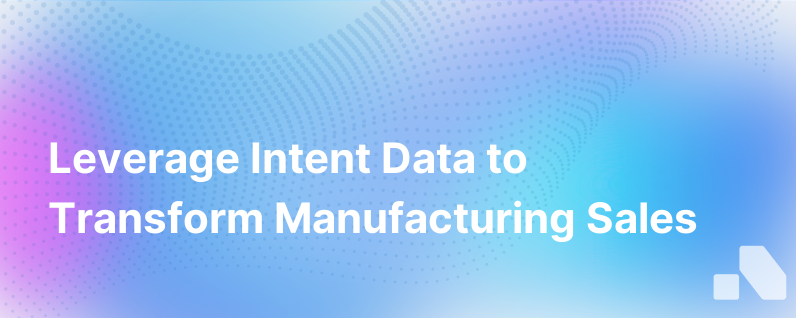
Integrating Intent Data into Manufacturing Sales and Marketing Strategies
Today's manufacturing industry is more competitive and data-driven than ever before. In an age where digital touchpoints are numerous and buyer journeys are complex, relying solely on traditional marketing strategies is akin to navigating a labyrinth blindfolded. Enter the power of intent data—a beacon that can illuminate the path to your most promising prospects. But what exactly is intent data, and how can manufacturers harness it to drive more informed sales and marketing strategies?
Intent data is a collection of signals that indicate a potential buyer's interest in certain topics, products, or solutions. This intelligence derives from online activities such as content consumption patterns, search queries, and engagement with digital resources. For manufacturers, utilizing intent data means identifying leads that are not only interested in what you offer but are actively researching and considering a purchase. The goal of incorporating intent data into your strategy is simple yet transformational—to engage with prospects at the right time, with the right message, and through the right channels
The Potential of Intent Data for Manufacturers
In the manufacturing sector, sales cycles can be lengthy, and purchasing decisions are often made by committees rather than individuals. The ability to identify and connect with stakeholders at critical moments in the decision-making process can significantly enhance sales outcomes. Here's how intent data can redefine the playing field:
- Precision Targeting: Manufacturers can identify and prioritize high-intent leads, allocating resources toward prospects most likely to convert.
- Personalized Engagement: By understanding the specific interests of each prospect, manufacturers can tailor their communication to address pain points, answer questions, and provide value.
- Timely Interaction: Sales teams can reach out to potential buyers at moments when their interest is strongest, which is often indicative of a looming purchasing decision.
- Account-Based Marketing: Intent data facilitates account-based marketing (ABM) approaches, allowing sales and marketing teams to align on targeting key accounts with bespoke campaigns.
- Market Insight: Analyzing aggregate intent signals provides manufacturers with insights into market trends, emerging needs, and potential areas for product development or innovation.
- Competitive Edge: Enabling manufacturers to respond promptly to buyer signals, intent data ensures you stay one step ahead of competitors in engaging qualified leads.
Uncovering Sources of Intent Data
Manufacturers can obtain intent data through first-party and third-party sources. First-party data includes engagement metrics from your website or digital assets, such as whitepapers or product sheets. Third-party data, on the other hand, often comes from specialized vendors that monitor buyer signals across various online platforms and industries.
Integrating Intent Data Into Your Manufacturing Marketing Stack
- CRM and Intent Data Synthesis: Incorporate intent data into your Customer Relationship Management (CRM) systems to enrich lead profiles. This integration helps sales and marketing teams gain access to up-to-date insights on buyer interests and behaviors.
- Content Alignment: Use intent data to develop and distribute content that resonates with your audience’s challenges and informational needs. For example, if a surge in interest for sustainable materials within the industry is detected, you can produce targeted content addressing this topic.
- Timing Campaigns for Maximum Impact: Schedule campaigns to align with spikes in intent signal activity. By doing so, manufacturers can capture the attention of buyers when they are most receptive.
- Sales Enablement: Arm your sales team with insights drawn from intent data, offering them the complete context needed to personalize outreach and advance conversations effectively.
- Measuring Engagement and Refinement: As sales and marketing efforts progress, continue to gauge and analyze engagement. Leverage intent data not only to assess the performance but also to refine strategies for future interactions.
Challenges and Best Practices
While intent data holds promise for manufacturers, it also presents challenges. High-quality intent data can be golden, but poor-quality data leads to misdirected strategies. Potential pitfalls include:
- Data Privacy Concerns: Adhering to data privacy regulations is crucial. Make sure your collection and use of intent data comply with global standards like GDPR and CCPA.
- Data Silos: Avoid having intent data trapped in one part of your organization. Ensure it's accessible and actionable across relevant departments.
- Inactionable Data: Work with reliable third-party data providers and validate first-party data to ensure it's rich enough to drive action.
To navigate these challenges, consider the following best practices:
- Partner with Reputable Vendors: Choose intent data providers with a proven track record in the manufacturing sector.
- Integrate and Act: Ensure seamless integration of intent data into your existing tech stack and move quickly to capitalize on insights.
- Train Your Teams: Invest in training your sales and marketing teams to interpret and act on intent data insights effectively.
- Test and Learn: Continuously test your intent data-driven strategies, learn from successes and misses, and iterate to improve over time.
A Real-World Application
Imagine a manufacturer specializing in high-precision tools. By monitoring intent data, they notice a trend in searches for "ultra-durable cutting equipment" among aerospace companies. With this intelligence, marketing creates targeted ads and educational content explaining their products' superior durability. Sales, on the other hand, prepares outreach scripts addressing this specific need, readying to engage leads the moment further intent signals are detected.
Conclusion
For manufacturing firms, leveraging intent data isn't just an innovative marketing exercise—it's an essential component of a modern, responsive, and customer-centric sales strategy. It empowers manufacturers to connect with potential buyers in a meaningful way, enhancing the customer experience while driving conversions and revenue. As the manufacturing landscape evolves, those equipped with the insights provided by intent data will be the ones deftly navigating the path to sustained growth and competitiveness.